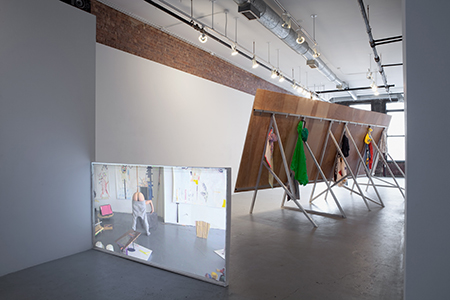In Focus: Anna K.E.
Sisyphean tasks and the failed Utopias of Modernist architecture
Sisyphean tasks and the failed Utopias of Modernist architecture

Nowhere in the Western tradition does the Utopianism of modernity find such concrete expression as in architecture. From Claude-Nicolas Ledoux and Étienne-Louis Boullée in 18th-century revolutionary France through to Le Corbusier and other Modernist architects of the early 20th century, notions of Utopia were associated with an architecture that is rational in structure and gravity-defying in appearance. In her first exhibition at Cologne’s Figge von Rosen gallery in 2011, entitled ‘Gone Tomorrow’, Anna K.E. placed a series of architectural models on wooden boards hung from the ceiling (‘Somewhere in the West’, 2007/11). The artist – who was born in 1986 in Tbilisi, Georgia, and studied in Germany at the art academies of Stuttgart and Dusseldorf – seemed to have created the models with archetypically Modernist properties in mind: functional in design, light and airy. But they also revealed a more playful, makeshift quality, with surreal elements such as awkwardly angled and decorated windows and sightlines; while they retained the clean lines of Modernist architecture, they displayed it already in the throes of decay, lending the work a nostalgic air. The models were accompanied by computer-generated drawings that exactly replicated the installation. Yet as to which came first – the drawings or the installation, the design or its realization – the artist left this question deliberately unanswered.
Another work in the Cologne show, Without Jewel (2007/11), consisted of a projector concealed in the sleeve of an extravagantly coloured fur jacket, which was suspended inside a simple metal structure. The footage, projected directly onto the wall, showed a scantily clad Anna K.E. trying to fold a double mattress over herself – a task at which she could never succeed, since the tension in the mattress caused it to unfold again each time. The hopelessness of this endeavour neatly encapsulates the central premise of the artist’s practice: the absurd failure of large-scale, ambitious projects, such as Modernist Utopias.

Another, more extreme, take on this theme can be found in a 2012 video in which the camera slowly pans across a naked female body, seductively arranged on the floor of what appears to be the artist’s studio, in a pose reminiscent of Giorgione’s Sleeping Venus (c.1510). At a certain point, the camera focuses in on the woman’s hip, on which a shapeless object is perched: a pile of the artist’s own shit. The work is titled God Created the World and I Did the Rest.
In an earlier video, Enough Sugar (2011), Anna K.E. kneels on a tiled board and, using two sticks as paddles, propels herself across the floor of her studio. Advancing at a snail’s pace, she eventually arrives at an open window, which she slams shut using one of the sticks – her apparently senseless and physically arduous mode of transport recalling the myth of Sisyphus. That the artist moves across the floor on a tiled board is significant, since tiles – which appear frequently in her installations – are indicative of the austere functionality and almost antiseptic purity of Modernism. In her show earlier this year, ‘the car was his and story mine’, she built a structure that resembled a billboard, but which was set at an angle like an easel. The front of the board was covered with white bathroom tiles to which she had applied abstract ceramic elements – recalling stickers or fridge magnets – to form a cheerful pyramid-shaped mosaic (Lucky Weekend, 2013). On the right-hand side of the structure, a new poster designed by a different artist friend was pasted on top of the one below it every other day, while on the reverse hung items of clothing printed with art works or slogans, such as ‘I Love Warhol’s Piss Paintings’. Projected onto a freestanding wall, set at an angle to the billboard, was the video Gloss of a Forehead (2011), in which a pair of naked buttocks move awkwardly around an artist’s studio, the legs to which they belong hampered by lowered trousers, while the top part of the body is bent forward so as to be out of sight. These, as you might have guessed, are the buttocks of Anna K.E., seen here shuffling around her studio in supreme absurdist fashion.

In the artist’s latest exhibition, ‘two whores in the same dress’ at Galerie Barbara Thumm in Berlin, more peculiar behaviour was on display. Screened opposite a platform on which a lady in traditional Georgian dress baked bread during the exhibition opening, the video Cultural Catalyst that Drives the Popular Dialogue Globally (2012) featured pointe-shoe clad feet moving gracefully around an artist’s studio. After a while, they come to halt and some liquid falls to the floor. This is the artist’s own piss: trained as a classical dancer, she herself is the incontinent ballerina. Once again, Anna k.e. manages to give the Sisyphean task of artistic creativity and failure a surreal, comic twist. In The Myth of Sisyphus (1942), Albert Camus declared we should imagine Sisyphus to be happy. The work of Anna K.E. implies not only that his laborious struggle was a happy one, but that it can be interpreted as a parody of excessively ambitious Utopian dreams.
Translated by Nicholas Grindell
Anna K.E. lives and works in New York, USA. Her solo shows have included ‘Gone Tomorrow’ at Galerie Figge von Rosen, Cologne, Germany; ‘Without Jewel’ at Kunstverein Leverkusen, Germany (both 2011); ‘the car was his and story mine’ at Simone Subal Gallery, New York; and ‘two whores in the same dress’, at Galerie Barbara Thumm, Berlin, Germany (both 2013).























